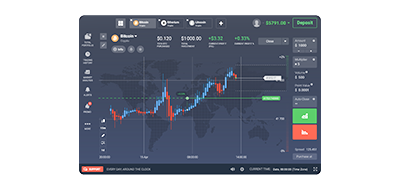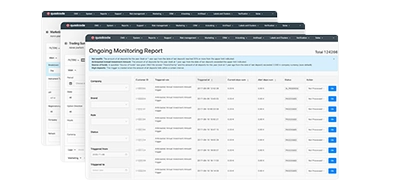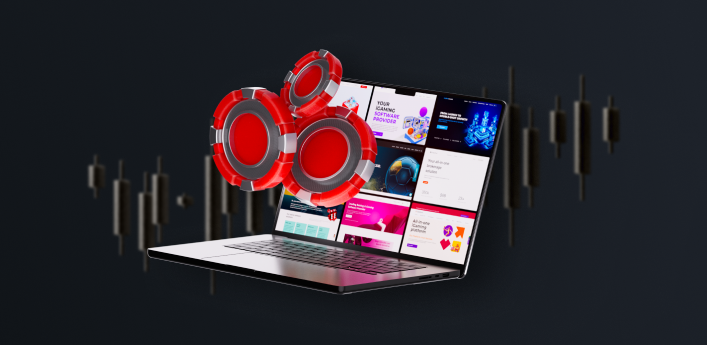Volver
Contents
¿Qué es la Nube Ichimoku?

Iva Kalatozishvili
Business Development Manager

Demetris Makrides
Senior Business Development Manager
La Nube Ichimoku es una herramienta de análisis técnico que los operadores pueden emplear para comprender la trayectoria potencial de los movimientos del mercado, las zonas de soporte y resistencia, y el impulso. Originario de Japón, este indicador de análisis técnico agrupa variables en un único gráfico para ofrecer una visión general de las tendencias del mercado. Al simbolizar el equilibrio del mercado y su aplicabilidad en diversos mercados y períodos, los operadores utilizan la Nube Ichimoku para guiar sus decisiones de trading.
Elementos de la nube Ichimoku
La Nube Ichimoku consta de cinco elementos que, en conjunto, proporcionan una descripción general de las tendencias del mercado, el impulso y los posibles niveles de soporte y resistencia.
Para empezar, el Línea de conversión El Tenkan Sen se calcula promediando el máximo y el mínimo a lo largo de nueve períodos. Esta línea contribuye a identificar tendencias a corto plazo. Puede actuar como una señal temprana de posibles cambios de tendencia. Ofrece a los operadores información sobre el momentum al reflejar las fluctuaciones recientes de los precios en el mercado.
Pasando a la Línea base (Kijun sen), ofrece una perspectiva diferente al promediar los máximos y mínimos de los últimos 26 períodos. Esta línea es importante, ya que no solo indica tendencias a mediano plazo, sino que a menudo funciona como nivel de soporte o resistencia. Los operadores pueden evaluar la tendencia del mercado basándose en el movimiento de Kijun sen, ya sea que sugiera una tendencia bajista o lateral.
El Tramo principal A (Senkou Span A), que representa un promedio de Tenkan sen y Kijun sen, se traza 26 períodos por delante del precio.
Este pronóstico marca un lado de la nube y ayuda a estimar los niveles de soporte o resistencia. Ofrece una perspectiva que permite a los operadores predecir dónde podrían surgir barreras de precio significativas.
A esto se suma el Tramo principal B (Senkou Span B) calculado promediando el máximo y el mínimo de los 52 períodos y proyectado de forma similar para los próximos 26 períodos. El espacio entre Senkou Span A y Senkou Span B está sombreado para formar el "Kumo" o nube. Esta nube sirve como zona de soporte y resistencia, y su grosor indica la fortaleza de estos niveles. Una nube más gruesa sugiere soporte o resistencia, mientras que una nube más delgada indica niveles más débiles.
Por último, el Tramo rezagado (Chikou Span) representa el precio de cierre. Se traza 26 periodos después del movimiento de precio más reciente. Esta señal rezagada permite a los operadores comparar los niveles de precios con datos históricos, lo que ayuda a confirmar la fuerza y la dirección de las tendencias. Al ilustrar cómo los precios actuales se alinean con los movimientos del mercado, el Chikou Span puede validar las señales de los elementos de la Nube Ichimoku.
La combinación de estos factores ofrece a los traders una perspectiva profunda del mercado, lo que convierte a Ichimoku Cloud en una herramienta valiosa para quienes buscan información sobre los movimientos de precios.
Cómo funciona la nube Ichimoku
La Nube Ichimoku integra estos elementos para presentar una visión de las condiciones del mercado. La característica principal es la nube creada por Senkou Span A y Senkou Span B, que ofrece una representación de los niveles de soporte y resistencia. Cuando el precio supera la nube, indica una tendencia. La nube actúa como nivel de soporte. Por el contrario, si el precio cae por debajo de la nube, indica una tendencia y actúa como barrera o resistencia.
El grosor de la nube también es importante. Una nube más densa implica un soporte o resistencia más fuerte, lo que dificulta que los precios la superen. Por otro lado, una nube más delgada sugiere niveles más débiles. Gracias a los ajustes que se producen con el tiempo, los operadores pueden anticipar las zonas de soporte y resistencia, lo que les permite planificar con mayor eficiencia sus entradas y salidas de operaciones.
Aplicación en la nube Ichimoku
Los traders utilizan la Nube Ichimoku para una variedad de propósitos, incluida la identificación de tendencias, la determinación de posibles reversiones y la determinación de puntos de entrada y salida de las operaciones.
Los operadores pueden determinar rápidamente la dirección del mercado analizando la posición del precio en relación con la nube. Si el precio está por debajo de la nube, indica una tendencia bajista; si está por encima, indica una tendencia alcista.
Para el mercado, la nube funciona como una zona dinámica de soporte o resistencia. Una vez que el precio sube a la nube, puede producirse una consolidación o una desaceleración. Una ruptura de la tendencia por encima o por debajo de la nube podría indicar que continuará o se revertirá.
La intersección de las líneas Tenkan-sen y Kijun-sen produce señales de compra y venta. Estas indicaciones pueden utilizarse para comprar o vender. Por ejemplo, si el precio es superior a la nube y la línea Tenkan-sen cruza la línea Kijun-sen, esto podría ser una señal clara de que es hora de comprar. Por el contrario, un cruce por debajo de la nube podría indicar una posible oportunidad para vender el activo.
Ventajas de utilizar la nube Ichimoku
Los operadores suelen preferir la Nube Ichimoku debido a sus ventajas, especialmente su capacidad para ofrecer una visión completa del mercado. Una de sus fortalezas reside en su capacidad de análisis. A diferencia de los indicadores que se centran en un solo aspecto del comportamiento del mercado, la Nube Ichimoku combina la identificación de tendencias, la evaluación del momentum y los niveles de soporte/resistencia en un solo gráfico. Esto permite a los operadores comprender la dinámica del mercado sin necesidad de indicadores que puedan saturar su análisis.
Otra ventaja significativa es la claridad visual y la facilidad de comprensión de la estructura de la nube. Su diseño único facilita la interpretación rápida de las condiciones del mercado, lo que ayuda a los operadores a determinar rápidamente si el mercado está en tendencia o en consolidación. Además, su formato con código de colores que identifica las zonas de soporte y resistencia resulta intuitivo, lo que permite a los operadores tomar decisiones mejor informadas.
La versatilidad de la Nube Ichimoku es otro factor destacado. Es un instrumento excelente para diversas estrategias de trading, ya que es compatible con una amplia gama de mercados y marcos temporales, incluyendo Forex, materias primas y acciones. Tanto si los operadores se especializan en inversiones a corto plazo, day trading o ambas, la Nube Ichimoku ha demostrado ser un valioso instrumento de mercado. Al proyectar los niveles de soporte y resistencia, esta nube ayuda a los operadores a anticipar los movimientos de precios antes de que ocurran. Este elemento predictivo ofrece a los operadores una ventaja sobre los indicadores técnicos que se basan principalmente en datos históricos. Con la Nube Ichimoku, los operadores pueden obtener información sobre las tendencias del mercado, lo que facilita la planificación estratégica de sus operaciones.
Desventajas de la nube Ichimoku
Si bien la Nube Ichimoku es una herramienta versátil, no está exenta de limitaciones. Para realizar operaciones informadas, los operadores que confían en esta indicación deben ser conscientes de estas limitaciones.
La Nube Ichimoku puede ser compleja, lo cual representa un gran obstáculo para algunos usuarios. El indicador incluye líneas y una región sombreada, comúnmente conocida como la nube, cuya interpretación puede ser difícil para principiantes.
La latencia de la Nube Ichimoku puede provocar la pérdida de oportunidades en mercados volátiles, donde los precios fluctúan con frecuencia. Es posible que los operadores descubran que ya se ha producido una fluctuación considerable de precios al momento de verificar una señal.
En escenarios donde la dirección del mercado no es clara, el indicador puede generar señales falsas, lo que podría resultar en pérdidas. La estructura de nube, que funciona bien en mercados con tendencia, podría no ofrecer niveles de soporte ni resistencia en mercados donde los precios fluctúan dentro de un rango estrecho.
Además, la configuración estándar de la Nube Ichimoku (9, 26, 52) se diseñó inicialmente para el mercado de valores japonés, que solía operar con una semana de negociación de seis días. En los mercados actuales, donde la semana de negociación de cinco días es la práctica habitual, esta configuración puede no ser siempre la ideal. El hecho de que los operadores a menudo tengan que ajustar la configuración para adaptarse a diferentes mercados y períodos añade un nivel adicional de complejidad a su uso.
Además, no todos los activos ni técnicas de trading funcionarán con la Nube Ichimoku, a pesar de su flexibilidad y aplicabilidad en todos los mercados. Por ejemplo, la fiabilidad de las señales proporcionadas por la nube puede verse reducida en mercados con poca liquidez o alta volatilidad debido a la baja precisión de predicción de la nube. Los operadores que se centran más en la alta frecuencia o el trading a corto plazo pueden encontrar la indicación demasiado compleja o lenta para sus necesidades.
Errores comunes al utilizar la nube Ichimoku
A pesar de su eficacia, los operadores suelen cometer errores al interpretar las señales de la Nube Ichimoku, lo que lleva a decisiones de trading erróneas. Un error frecuente es centrarse en los componentes de la nube en lugar de considerar su estructura general. Por ejemplo, algunos operadores pueden confiar demasiado en los cruces de Tenkan sen y Kijun sen sin tener en cuenta el contexto proporcionado por la propia nube o el Chikou Span. Este descuido puede provocar que se abran posiciones de trading sin comprender las condiciones imperantes del mercado.
Otro error frecuente es ignorar la densidad de la nube. Los operadores que pasan por alto este aspecto podrían operar prematuramente, sin percatarse de que niveles de resistencia o soporte significativos podrían obstaculizar el movimiento del precio antes de que se ajuste a sus expectativas.
Los traders también cometen a veces el error de aplicar configuraciones predeterminadas para la Nube Ichimoku en todos los mercados y períodos de tiempo.
La configuración predeterminada se creó para adaptarse a un entorno de mercado específico. Puede que no sea ideal para todas las situaciones de trading. No ajustar esta configuración a las condiciones variables del mercado o a los plazos puede generar señales y decisiones de trading desfavorables.
Además, confiar únicamente en la Nube Ichimoku sin verificar las señales con otros indicadores o métodos de análisis es otro error común. Si bien la Nube Ichimoku es exhaustiva, funciona mejor cuando se utiliza junto con herramientas como indicadores de volumen o análisis fundamental. Este enfoque ayuda a prevenir señales y ofrece una perspectiva integral del mercado.
Personalización de la nube Ichimoku
Por sí solo, la Nube Ichimoku es un indicador muy potente. Sin embargo, puede ser aún más potente si se ajusta adecuadamente a mercados y marcos temporales específicos. Como se mencionó anteriormente, la aplicación original de este indicador fue el mercado bursátil japonés, que opera con una semana de negociación de seis días. Por lo tanto, debe ajustarse a las condiciones actuales del mercado.
Al usar la nube en el mercado Forex, los operadores suelen ajustar la configuración a períodos más cortos, como 7, 22 y 44 (no se considera asesoramiento financiero). Cambiar a esta configuración permite que las señales reflejen mejor la naturaleza 24/5 del mercado Forex. Al usar la Nube Ichimoku para operar con materias primas o acciones, también es necesario realizar ajustes. Estos mercados suelen reaccionar a fuerzas e influencias externas, como la oferta y la demanda, fenómenos meteorológicos o tensiones geopolíticas. Para garantizar señales fiables, la configuración de la Nube debe ajustarse y perfeccionarse para identificar y capturar las tendencias actuales del mercado.
La Nube Ichimoku también se puede ajustar en diferentes marcos temporales, según las particularidades de la operación. Por ejemplo, un day trader o scalper y un swing trader deberán ajustar los marcos temporales según corresponda.
Los operadores a corto plazo, como los day traders o los scalpers, suelen usar los gráficos de 5 y 15 minutos de la Nube Ichimoku para capturar tendencias, observar el impulso del mercado e identificar puntos de entrada y salida. En los marcos temporales más cortos, la nube puede responder y ajustarse con mayor rapidez a las fluctuaciones de precios.
Los operadores que prefieren operar en marcos temporales más largos, como los swing traders o los inversores, suelen utilizar los gráficos diarios y semanales con la nube. Dado que no les afecta la volatilidad a corto plazo del activo, los marcos temporales más amplios suavizan y eliminan el ruido a corto plazo, destacando las tendencias significativas, así como los principales niveles de soporte y resistencia que desempeñan un papel fundamental en el trading a largo plazo.
Conclusión
La Nube Ichimoku es una herramienta versátil que ofrece a los operadores una visión general del mercado. Al consolidar elementos en un solo indicador, ofrece una visión detallada de las tendencias, el impulso y los niveles de soporte/resistencia. Ya sea para identificar tendencias, detectar reversiones o planificar operaciones, incorporar la Nube Ichimoku a su arsenal de trading es crucial. Dominar este indicador puede mejorar considerablemente su capacidad para navegar por los mercados con confianza y precisión.
Actualizado:
19 de diciembre de 2024




